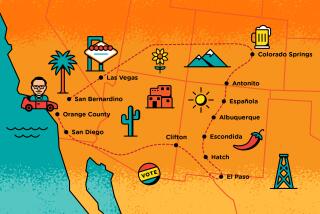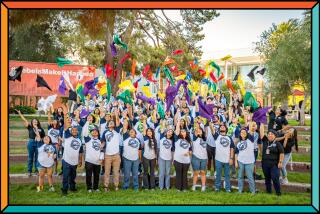Latinos Urged to Head for the Polls
At 7:45 a.m. on a recent cloudy morning, Salvadoran emigrant Rafael Rosales was answering some rather embarrassing questions.
Are you a habitual drunkard? Are you a prostitute or have you ever procured the services of one? Have you ever sold or smuggled narcotics?
No, he said to all.
Rosales is no criminal suspect. Along with 35 classmates at Evans Community Adult School near Chinatown, the 36-year-old Santa Fe Springs steelworker is an aspiring American being led through questions for the U.S. government’s citizenship exam. Inspired by the last few months of pro-immigrant marches and rallies, Rosales said, he aims to become a citizen by November so he can vote for policies that aid immigrants like himself.
He represents the potential new Latino voter whom immigrant rights organizations are targeting as they kick off a campaign to produce 1 million new citizens and voters this year, beginning with a “national lobby day” today.
The civic action campaign, coordinated by religious, labor and community organizations in the We Are America Alliance, aims to channel street passions for immigrant rights into a muscular political force that can persuade Congress to legalize the nation’s estimated 12 million illegal migrants, increase family visas and approve other reforms.
“This is a way to continue building on the momentum of the marches by building political power,” said Angelica Salas, executive director of the Coalition for Humane Immigrant Rights of Los Angeles. “We want to be a force in our community and participate in determining our future,” she added.
Los Angeles immigration alliance members announced Tuesday that they would begin registering voters, handing out citizenship materials and offering postcards and phones to use in contacting elected representatives today at about 50 “democracy centers” set up at churches, union halls and community centers around the region.
They also said they would send an 18-member delegation to Washington, D.C., today to lobby for “just and humane” immigration reform and against President Bush’s plan to use the National Guard to protect the U.S.-Mexico border.
Organizers face both tantalizing possibilities and tough challenges in their quest to expand the Latino electorate. With as many as 12 million potential new voters -- both legal residents eligible for citizenship and citizens not yet registered to vote -- the community could nearly double its 2004 vote.
But, with the exception of Cubans, Latinos have comparatively low rates of citizenship and voter registration.
Only one of every five Mexican adult immigrants in the United States, for instance, was a citizen in 2004, according to the Pew Hispanic Center, a nonpartisan research group based in Washington, D.C.
In addition, some immigrants could have a tough time meeting citizenship requirements, which include English language ability and a $400 application fee.
Low rates of citizenship, along with the Latino community’s relative youth, is why only 39% of the nation’s 41 million Latinos are eligible to vote, compared with 76% of whites and 65% of blacks, said Pew Center director Roberto Suro. Of those 16 million eligible Latinos, 58% were registered for the last presidential election, he said.
The largest single pool of potential new Latino voters is also regarded as among the most difficult to organize: Native-born citizens between the ages of 18 and 29.
In addition, voter registration drives can be costly. Experts say it could cost at least $5 million to meet the voting campaign’s registration goals. And get-out-the-vote work isn’t easy.
The tedium of vote-gathering was evident last week, when volunteers from the Central American Resource Center set out to nudge those who don’t vote regularly to go to the polls next month in 33 precincts in the Pico-Union district of Los Angeles.
Trudging along Burlington Avenue, past Central American markets, money-wiring shops and Our Lady of Guadalupe murals, Liz Yaeger and Flor Vera encountered locked apartment gates, broken call boxes, barking dogs, several children and older relatives -- but very few voters. Most of those who answered the doors said the voter in question was away at work, including one on duty in Iraq.
After two hours, Yaeger and Vera had managed to meet only one of about 20 voters on their list. It was Yaegar’s third outing that week; all told, she contacted 11 of 60 voters in six hours of precinct walking.
“It’s definitely labor-intensive,” she said.
Still, Latino activists say the marches, which drew hundreds of thousands of people, have sparked new enthusiasm -- and a sense of urgency -- among Latinos to project their civic voice.
Maria Teresa Petersen, executive director of the New York-based Voto Latino, said her e-mails from youths wanting to volunteer for the voting effort has leaped from 50 a month to 200 a week.
Her group, founded in 2004 by actress Rosario Dawson and other Latino celebrities, is tackling head-on the 4.9 million eligible Latino voters younger than 30. Fewer than half of them were registered to vote in 2004.
Suro said young native-born Latinos are more sympathetic to immigrants than their middle-aged counterparts, in part because many have directly witnessed the struggles of migrant parents or relatives.
That personal connection to immigrants can be used to motivate young people to vote, said Ricardo Ramirez, a USC assistant political science professor.
To reach its young audience, Voto Latino has produced public service announcements featuring actress Cameron Diaz and reggaeton artist Tego Calderon. It has organized “street teams” of party promoters and other young Latino trendsetters -- called “Kool Kids” -- to create buzz about voting at concerts and other youth venues.
By employing a paperless approach based on Internet use and cellphone text-messaging, Petersen said, the group hopes to cut costs by at least half. She added that Voto Latino expects to make a major push in Los Angeles this year, with plans to set up street teams and hold its annual fundraiser in the city.
One young Latino already on board is Fernando Franco, a Belmont High School senior who turned 18 in January and has registered to vote.
The native-born son of immigrants from Mexico and Ecuador, Franco said he walked out of school and joined the downtown Los Angeles march on May Day and, like many of his friends, would not miss the chance to vote this year.
“I’ve never seen my friends this passionate about anything,” he said.
Excitement over Latino political empowerment was also evident at the Evans school, where about 7,400 are enrolled in English and citizenship classes this spring.
Rosales and classmate Guadalupe Herrera of Mexico said the marches had created a surge of interest in their communities about joining the American electorate.
With processing times for citizenship applications reduced from more than a year to less than six months in Los Angeles, the men could potentially cast their first vote this November.
“We want people to hear our voices,” said Herrera, a truck driver who is scheduled for his citizenship interview in June.
“And the only way you can do that,” Rosales said, “is to be a U.S. citizen and vote.”
*
(BEGIN TEXT OF INFOBOX)
Lower registration, turnout
Among those who are eligible to vote, Latinos have been less likely to register and less likely to vote than whites or blacks. The numbers from November 2004:
Percentage of registered voters among those eligible
Latino: 58%
White:75%
Black: 69%
Overall: 72%
Percentage of voters among those registered
Latino: 82%
White: 89%
Black:87%
Overall:89%
More to Read
Sign up for Essential California
The most important California stories and recommendations in your inbox every morning.
You may occasionally receive promotional content from the Los Angeles Times.











